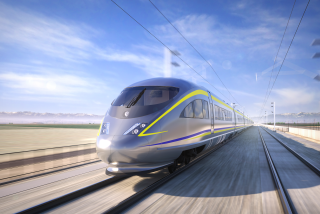Australia’s Plan for North-South Railway Gathers Steam
SYDNEY, Australia — Some of the most barren and inhospitable land in the world lies between Australia’s southern and northern coasts, almost 2,000 miles of desert, dry scrub and moonscape.
For some people, including government leaders, it is a barrier that must be conquered to increase trade between Asia and southeast Australia, where the vast majority of the country’s 18 million people live.
The answer, they say, is to run a railroad from the populous south to the isolated north coast to carry goods from Australian factories to the consumers of Asia. Proponents say it would be a boon for the economy--and also bring a growth boom in “the outback.”
Critics characterize the proposal as an expensive boondoggle for which there is no business need, saying ocean-going ships can handle the trade more efficiently.
The government heated up the debate by promising in August to help finance one of two competing plans for laying rails across the desert--one that would run from the small northern port of Darwin to Adelaide on the south coast. The other calls for a line from Darwin to Melbourne.
“I see an Australia which is going to have large cities all the way along this railway line, and it is simply going to develop Australia the way the middle of the United States developed,” says Everald Compton, who heads the Melbourne-Darwin bid.
His Australian Transport and Energy Corridor Pty. Ltd. says its proposed $7.4-billion railroad would create jobs and inject new life into flagging rural economies along the way.
“America developed the middle and we didn’t,” Compton says. “We all sit around on the coast on the beaches and drink beer, and the rest of the country goes to pot. This is going to change it totally. We will have cities eventually like St. Louis and Kansas City.”
Opponents say predictions that towns and cities will spring to life from the desert along the railway’s length are fantasy. No such cities emerged in the Nullabor Plain on the route of the existing east-west railway, they note.
The Darwin-Melbourne run would be a completely new line, while the Darwin-Adelaide route would include track that already runs from the south to Alice Springs, about halfway across central Australia.
Prime Minister John Howard agreed to provide $74 million from the federal government for the Adelaide plan.
The state governments of South Australia and Northern Territory each committed like amounts to the project. But they say the federal contribution needs to be three times larger to stimulate the $525 million in private investment needed to pay for the $740-million project.
Private involvement is another area where the critics are skeptical. They note that a letter of interest signed by the South Korean construction giant Daewoo Corp. and the Northern Territory government expired last year.
Daryl Phillips, an executive with the international shipping company P&O; Nedlloyd Ltd., says all a railroad would do is add an extra stage in moving goods between Australia and Asia.
Calls for the railway dovetail with a push by Northern Territory to build Darwin, a city of barely 170,000 people, into Australia’s trade gateway to Asia. A $60-million deep-water port, which will be vastly underused without a rail link, is already partly built.
The history of railroads in Australia is far from reassuring.
Until federation united the former British colonies in 1901, Australia was effectively a continent of separate nations, and its rail network developed without a master plan.
Lasting disorder resulted, with different rail gauges and rolling stock throughout the country. For example, until 1970, passengers and freight traveling between Brisbane on the east coast and Perth on the west had to change trains five times.
Perhaps not surprisingly, the vast bulk of Australia’s 1 billion tons of freight a year is carried by truck.
Federal Treasurer Peter Costello describes the Darwin-Adelaide railway as “visionary.”
But Philip Laird, a transportation expert at Wollongong University, says Australia’s railways are rundown and there are more pressing needs for the money that would be spent on a new rail line.
He says $1.7 billion will be needed over the next decade for upgrades.
“That should have a higher priority than Adelaide-Alice Springs-Darwin,” he says.
More to Read
Sign up for Essential California
The most important California stories and recommendations in your inbox every morning.
You may occasionally receive promotional content from the Los Angeles Times.








